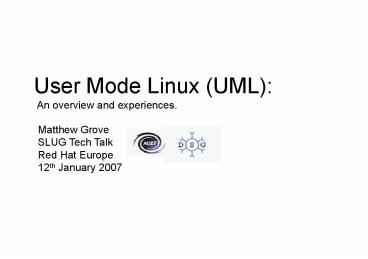User Mode Linux (UML): An overview and experiences. PowerPoint PPT Presentation
1 / 13
Title: User Mode Linux (UML): An overview and experiences.
1
User Mode Linux (UML) An overview and
experiences.
Matthew Grove SLUG Tech TalkRed Hat Europe12th
January 2007
2
Outline
- What is UML?
- A very brief overview of x86 virtualisation,
- UML Architecture,
- Running UML,
- Gonzo a mini case-study.
3
What Is UML?
- UML is a port of the Linux kernel to Linux, Jeff
Dike is maintainer and work started in 1999. - Linux has been ported to a wide variety of
architectures, for example - Alpha, ARM, i386, IA64, M68K, MIPS, MIPS-64,
PA-RISC, PowerPC, PowerPC64, IBM S/390, IBM
S/390x, SH, SH64, SPARC, SPARC64, x86-64. - UML lets you compile the vanilla Linux kernel
sources into a standard Linux user-land
executable. - UML is an example of a virtual machine (VM). In
simple terms a VM allows multiple operating
systems to share a single hardware resource.
4
Why Use Virtual Machines?
- Support heterogeneous applications using one
physical machine (I.E. Win32 and Linux apps), - Consolidate workloads,
- Allows the execution environment to be tailored
to the application, - Run legacy applications,
- Secure sandboxes for untrusted applications,
- By managing resources you can get QoS,
- Make system mobility easier to implement.
5
x86 Virtualisation
- The x86 was not designed with virtualisation in
mind. - You must either trap and modify some calls
(overhead), - Or modify the guest OS (can perform better).
- Two techniques for accessing resources
- Full virtualisation (looks like a normal x86),
- Para-virtualisation (present real and virtual
resources to the OS). - Some new x86 chips contain some features to
overcome some virtualisation issues.
6
UML Architecture
-------------------------- Process 1
Process 2 ... --------------------------
Linux Kernel --------------------
-------- Hardware
----------------------------
- Normally your user-land processes
- talk to the Linux kernel which in turn
- accesses the hardware.
----------------
Process 3 ... ---------------------------
Process 1 User-Mode Linux
---------------------------- Linux
Kernel ----------------------------
Hardware
----------------------------
- Under UML your process talks to
- the UML kernel which then
- communicates with the host kernel
- in the same way that any user-land
- application would.
7
Some UML Details
- UML will execute on Linux gt2.2. The UML kernel
does not need to match the host kernel (you could
run 2.4 on 2.6). - The Separate Kernel Address Space (SKAS) patch
makes the UML kernel inaccessible from the guest
making UML secure and suitable for honey-pots.
8
Gonzo Mini Case-Study
- Situation
- I have consolidated most of my computing needs
into one server. - This server is critical to life as we know it,
because among other things it provides the email
and the TV backend. - The server runs Debian Sarge.
- Requirements
- I wanted to have Internet facing services and
provide remote access to home without having my
server directly accessible on the net. - If possible I also wanted the option to easily
host services not available in Sarge.
9
Why I Chose UML
- I didnt want another server I had 7 before
consolidation efforts and for financial, space
and relationship reasons no extra computers
allowed! - UML provided me
- A mechanism for running Debian Testing on my
server along side Sarge. - A GPL solution using mature code,
- Did not require changes to the host server OS or
hardware (although I did use the SKAS patch). - No performance impact on the other duties of the
host server.
10
Building, Installing and Running
- Prepare the host system
- Apt-get the UML tools and configure networking.
- Build a UML kernel,
- UML is included in the mainline 2.6 kernel.
- Install a guest operating system,
- There are many options for this. I created a file
to contain the guest OS. I used the debootstrap
script to install Debian onto this file system. - Boot UML.
- ./linux ubd0sarge.disk ubd1swap.disk
con0fd0,fd1 conpts eth0tuntap,tap0 mem128M
umidgonzo - Automate starting the machine.
11
gonzo.ninja.me.uk
12
Unscientific Performance Evaluation
- Time to compile the Linux 2.6.18.4 kernel
13
Links
- UML project page
- http//user-mode-linux.sourceforge.net/
- Running Debian inside of Debian with User-Mode
Linux - http//eggdrop.ch/texts/uml/
- Bytemark (UML) Hosting
- http//www.bytemark.co.uk/
- The UML book
- User Mode Linux, Jeff Dike. Prentice Hall
- PTR, 2006 , ISBN-10 0131865056.

